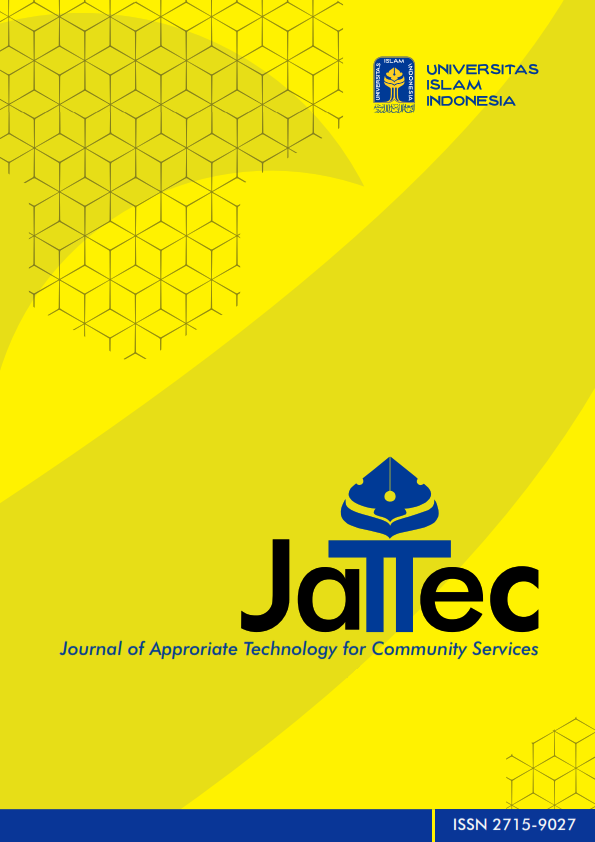Main Article Content
Abstract
Community empowerment is a process towards being empowered by actively involving society. There have been empowerment programs that failed because of no community's participation inside the programs. The effectiveness of a community empowerment program is depend on the level of community participation in it. This happened because society knows their needs, problems, and potential. An effort to achieve the effectiveness of community empowerment is needed technique to achieve ideal conditions reached easier. One of the techniques that can be used is Technology of Participation (ToP). The technology of Participation is a technique that assists in making decisions with a participatory approach. This research has aim to describe the benefits of using the Technology of Participation in community empowerment programs. This research uses a qualitative approach with a case study method. The case study design used is a single-case design that focuses on empowerment programs that carried out in Cisambeng Village. This result of this research shows that there is a different community response to participation in empowerment Participation (ToP).
Article Details
References
- Adi, I. R. (2007). Perencanaan Partisipatoris Berbasis Aset Komunitas dari Pemikiran Menuju Penerapan. Depok: FISIP UI Press.
- Adisasmita, R. (2006). Membangun Desa Partisipatif. Yogyakarta: Graha Ilmu.
- Cendekia, I., Sudarno, R., & Saifullah. (2010). Metode Fasilitasi Pembuatan Keputusan Partisipatif (Revisi). Jakarta Timur: PATTIRO and The Ford Foundation
- Harsanto, J., Heryana, W., & Nurjanah. (2018). Penguatan Kapasitas Forum Komunikasi Warga dalam Penanganan Konflik Sosial di Kabupaten Bandung. Pekerjaan Sosial, Vol.16 (2), 345–358.
- Huraerah, A. (2011). Pengorganisasian dan Pengembangan Masyarakat: Model dan Strategi Pembangunan Berbasis Kerakyatan. Bandung: Humaniora.
- Kalesaran, F., Rantung, V. V, & Pioh, N. R. (2015). Partisipasi dalam Program Nasional Pemberdayaan Masyarakat Mandiri Perkotaan Kelurahan Taas Kota Manado. Acta Diurna, Vol. IV (5).
- Karianga, H. (2011). Partisipasi Masyarakat dalam Pengelolaan Keuangan Daerah: Perspektif Hukum dan Demokrasi. Bandung: Alumni.
- Laksana, N. S. (2013). Bentuk-bentuk Partisipasi Masyarakat Desa dalam Program Desa Siaga di Desa Bandung Kecamatan Playen Kabupaten Gunung Kidul Provinsi Daerah Istimewa Yogyakarta. Kebijakan Dan Manejemen Publik, Vol. 1 (1), 56–67.
- Moleong, L. J. (2015). Metodologi Penelitian Kualitatif. Bandung: Remaja Rosdakarya.
- Rahman, K. (2016). Pemberdayaan Partisipasi Masyarakat Dalam Pembangunan Desa. WEDANA Jurnal Pemerintahan, Politik Dan Birokrasi, Vol.2 (1), 189–199.
- Sugiyono. (2014). Meotde Penelitian Kuantitatif, Kualitatif, dan R&D. Bandung: Alfabeta.
- Suharto, E. (2010). Membangun Masyarakat Memberdayakan Rakyat. Bandung: Refika Aditama.
- Suryana, S. (2010). Pemberdayaan Masyarakat. Jakarta: Bumi Aksara.
- The Asia Foundation. (2008). Technology of Participation (ToP): Basic Group Facilitation Techniques. Sri Lanka: Ministry of Local Government and Provincial Council and The Sri Lanka Institute of Local Government
- Wicaksono, K. A. (2017). Partisipasi Masyarakat dalam Pemberdayaan Masyarakat melalui Pengembangan Desa Wisata (Dewi) Menari Dusun Tanon Desa Ngrawan Kecamatan Getasan Kabupaten Semarang. 12 Juni 2020
- http://eprints.ums.ac.id/54710/1/KRISNA ARDHI W L100100127 FIX.pdf
- Widjajanti, K. (2011). Model pemberdayaan masyarakat. Jurnal Ekonomi Pembangunan, Vol.12 (1), 15–27.
- Wirastuti, A. R., & Wardani, A. I. (2015). Faktor-faktor yang Memengaruhi Partisipasi Masyarakat pada Program Pemberdayaan Masyarakat Kelurahan (PPMK) di Kelurahan Kampung Melayu Jakarta timur. 13 Juni 2020
- http://lib.ui.ac.id/detail?id=20403237&lokasi=lokal
- Yin, R. K. (2009). Case Study Research: Design and Methods (California). Sage Inc.
References
Adi, I. R. (2007). Perencanaan Partisipatoris Berbasis Aset Komunitas dari Pemikiran Menuju Penerapan. Depok: FISIP UI Press.
Adisasmita, R. (2006). Membangun Desa Partisipatif. Yogyakarta: Graha Ilmu.
Cendekia, I., Sudarno, R., & Saifullah. (2010). Metode Fasilitasi Pembuatan Keputusan Partisipatif (Revisi). Jakarta Timur: PATTIRO and The Ford Foundation
Harsanto, J., Heryana, W., & Nurjanah. (2018). Penguatan Kapasitas Forum Komunikasi Warga dalam Penanganan Konflik Sosial di Kabupaten Bandung. Pekerjaan Sosial, Vol.16 (2), 345–358.
Huraerah, A. (2011). Pengorganisasian dan Pengembangan Masyarakat: Model dan Strategi Pembangunan Berbasis Kerakyatan. Bandung: Humaniora.
Kalesaran, F., Rantung, V. V, & Pioh, N. R. (2015). Partisipasi dalam Program Nasional Pemberdayaan Masyarakat Mandiri Perkotaan Kelurahan Taas Kota Manado. Acta Diurna, Vol. IV (5).
Karianga, H. (2011). Partisipasi Masyarakat dalam Pengelolaan Keuangan Daerah: Perspektif Hukum dan Demokrasi. Bandung: Alumni.
Laksana, N. S. (2013). Bentuk-bentuk Partisipasi Masyarakat Desa dalam Program Desa Siaga di Desa Bandung Kecamatan Playen Kabupaten Gunung Kidul Provinsi Daerah Istimewa Yogyakarta. Kebijakan Dan Manejemen Publik, Vol. 1 (1), 56–67.
Moleong, L. J. (2015). Metodologi Penelitian Kualitatif. Bandung: Remaja Rosdakarya.
Rahman, K. (2016). Pemberdayaan Partisipasi Masyarakat Dalam Pembangunan Desa. WEDANA Jurnal Pemerintahan, Politik Dan Birokrasi, Vol.2 (1), 189–199.
Sugiyono. (2014). Meotde Penelitian Kuantitatif, Kualitatif, dan R&D. Bandung: Alfabeta.
Suharto, E. (2010). Membangun Masyarakat Memberdayakan Rakyat. Bandung: Refika Aditama.
Suryana, S. (2010). Pemberdayaan Masyarakat. Jakarta: Bumi Aksara.
The Asia Foundation. (2008). Technology of Participation (ToP): Basic Group Facilitation Techniques. Sri Lanka: Ministry of Local Government and Provincial Council and The Sri Lanka Institute of Local Government
Wicaksono, K. A. (2017). Partisipasi Masyarakat dalam Pemberdayaan Masyarakat melalui Pengembangan Desa Wisata (Dewi) Menari Dusun Tanon Desa Ngrawan Kecamatan Getasan Kabupaten Semarang. 12 Juni 2020
http://eprints.ums.ac.id/54710/1/KRISNA ARDHI W L100100127 FIX.pdf
Widjajanti, K. (2011). Model pemberdayaan masyarakat. Jurnal Ekonomi Pembangunan, Vol.12 (1), 15–27.
Wirastuti, A. R., & Wardani, A. I. (2015). Faktor-faktor yang Memengaruhi Partisipasi Masyarakat pada Program Pemberdayaan Masyarakat Kelurahan (PPMK) di Kelurahan Kampung Melayu Jakarta timur. 13 Juni 2020
http://lib.ui.ac.id/detail?id=20403237&lokasi=lokal
Yin, R. K. (2009). Case Study Research: Design and Methods (California). Sage Inc.

